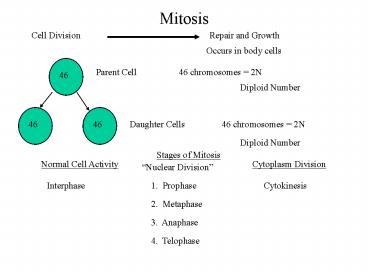Mitosis - PowerPoint PPT Presentation
1 / 16
Title:
Mitosis
Description:
As a cell grows, the volume of the inside grows at a faster rate than the ... 23. 23. 23. 23. Spermatogenesis. Oogenesis. Sperm. Egg. Disintegrate. Polar bodies ... – PowerPoint PPT presentation
Number of Views:924
Avg rating:3.0/5.0
Title: Mitosis
1
Mitosis
Cell Division
Repair and Growth
Occurs in body cells
46 chromosomes 2N
46
Diploid Number
46 chromosomes 2N
Diploid Number
Stages of Mitosis
Normal Cell Activity
Cytoplasm Division
Nuclear Division
Interphase
1. Prophase
Cytokinesis
2. Metaphase
3. Anaphase
4. Telophase
2
Why Cells Need to Divide
As a cell grows, the volume of the inside grows
at a faster rate than the surface area of the
membrane.
Food
Oxygen
Waste
Carbon dioxide
Soon there is not enough surface area to provide
the volume with good things and take away the
bad things the cell must divide.
3
Interphase
- Normal cell activity
- Chromosome material is in a long, thin,
invisible form called chromatin - Cell spends most of its time in interphase
- Cell growing
- Toward end of interphase, DNA replicates
4
Mitosis are the steps for the nuclear material
to divide
1. Prophase
- Nucleus and Nucleolus disappear
- Chromatin coils on self to form short, thick
visible Chromosomes - Centrioles move to the opposite sides of the cell
- Spindle made of protein fibers form between the
Centrioles
5
2. Metaphase
- Chromatids line up at the equator
6
3. Anaphase
- Chromatids separate and move to opposite sides of
the cell
7
4. Telophase
- Nucleus and Nucleolus reappear
- Chromosomes uncoil to form long, thin invisible
Chromatin - Centrioles move back together outside of nucleus
- Spindle dissolves
8
Cytokinesis
- Cytoplasm pinches in and divides in animal cells
- A cell plate forms in plant cells
9
Meiosis
Reproduction
Makes egg and sperm
Occurs only in reproductive organs
female
male
ovaries
testes
eggs
sperm
2N Diploid
46
Called Reduction Division
1N Haploid
10
Zygote Fert. Egg
46
2N
YOU
Trait 2 genes
11
Homologous Pairs Chromosomes with genes in the
same sequence or order. Does not mean the same
genes, just the same order.
12
During Late Interphase, the chromosomes make a
copy of themselves and are held together by a
centromere.
Homologous Pair
13
Match up the homologous pairs
What is the 1N number of this cell?
What is the 2N number of this cell?
14
Meiosis
4
2N
Late Interphase
Homologous Pairs
1st Metaphase
2nd Metaphase
2
1N
15
(No Transcript)
16
Egg
Sperm































